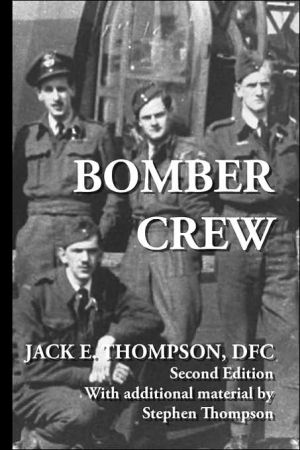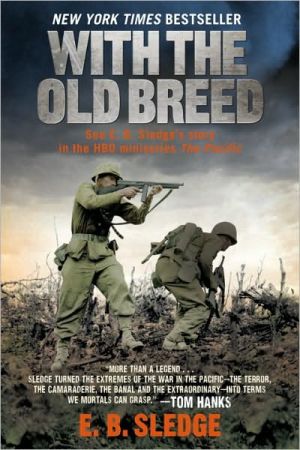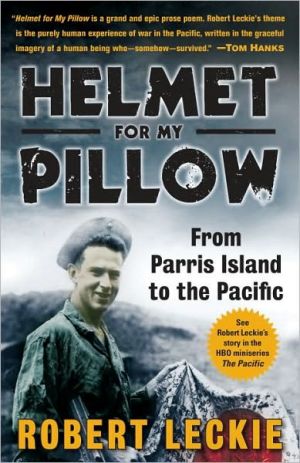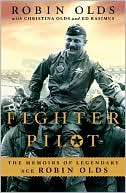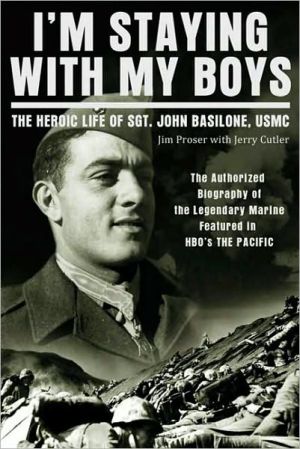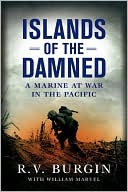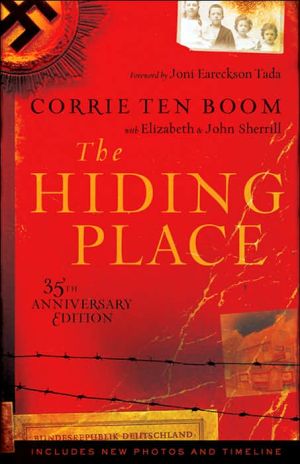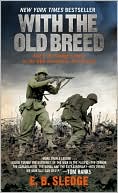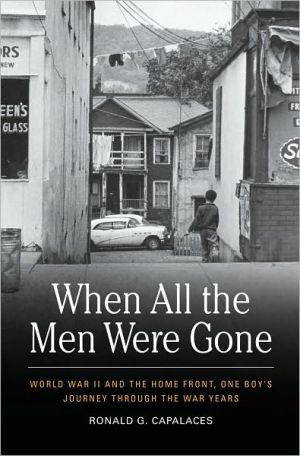Bomber Crew
Bomber Crew was self-published by the author, Jack E. Thompson, in 1989. This second edition has been re-published to acknowledge the 60th anniversary of VE-Day, to commemorate 2005 as the Year of the Veteran and to help celebrate the life of Jack E. Thompson (1923-2003). Some additional material including photographs, not available for the original version, have been added by the author's son, Stephen Thompson. \ \ Bomber Crew is the record of a tour of duty of the crew of the Lancaster...
Search in google:
Experiences of a mostly Canadian crew of a Lancaster bomber through one tour of duty in England and Europe during World War II.
BOMBER CREW\ \ By JACK E. THOMPSON \ Trafford Publishing\ Copyright © 2005 Jack E. Thompson\ All right reserved.\ ISBN: 978-1-4120-6715-7 \ \ \ Chapter One\ Ron had dumped the landing gear and flaps and we were coasting in, a steady 120 MPH showing on the airspeed indicator. The final approach to the end of the runway was nicely lined up and I was listening to the short, terse announcements from arriving aircraft as their skippers called up to receive landing instructions. \ I glanced over at Ron. He grinned back. We were doing our thing that we had done many times before but this time it was different. This time it was a particularly happy occasion shadowed slightly by overtones of sadness. We knew that we would never be doing this again together. The rest of the crew in their various locations in the big flying machine were silent, all seven of us sharing the elation and, at the same time, the finality of our time together.\ My concentration on the approach was suddenly broken by the finely-modulated English-accented voice which interrupted the steady flow of communications between air and ground.\ "Careful, Tommy, careful!"\ The message coming through my headphones made me chuckle with delight.\ "That's that old bugger Frank Watt," I told the others.\ Frank's message was a warm and personal acknowledgement of the particular significance of our imminent touch-down and also let us knows that he too had returned safely from the operation. Trust him to ignore radio procedure rules on this important occasion for both of us. I was too busy to make a reply as we swished down over the end of the runway.\ And what an important occasion it was! Our two crews, with this flight, completed the final operation of our tours and could now look forward to a period of much more relaxed living. No longer were we faced with the knowledge that our next trip aloft might be our final goodbye to life.\ We landed and taxied clear of the runway continuing along the perimeter strip to the hard-stand where we shut down the engines.\ We'd made it! It was a smiling, joking crew who carted their parachutes and other equipment to the door and descended the ladder one by one to terra firma. An M.T. section truck was standing by to carry us to the briefing hut where debriefing would be the final formality of our tour.\ The date was November 6, 1944, a cheerful blue-sky day, unusual for England at this time of year. Over Germany, bright sunlight and a blue sky had also predominated but its smiling innocence had not misled us. Unlike Irving Berlin's "Blue skies smiling at me" the German sky was anything but the optimistic description in Berlin's next line, "Nothing but blue skies do I see".\ Blue the sky may have been but its beauty was marred by myriads of black puffs from exploding anti-aircraft shells. The air corridor we travelled had become a deadly sea of bursting charges.\ Our target, Gelsenkirchen, was in the heavy industrial section of Germany, the Ruhr, known to bomber crews as "Happy Valley". Looking at the countless disintegrating smoke clusters from flak bursts drifting by on each side of us it seemed as though the route had been chosen to expose us to the most anti-aircraft fire over the longest possible period.\ But as someone said during our first days on the squadron, "You don't have to worry about the black puffs, they're already done." And this was true of course but, where there was a great concentration of visible anti-aircraft fire, there were bound to be many as yet unexploded shells whizzing by just ready to demolish an aircraft or at least inflict considerable damage. This was certainly one of the heaviest concentrations of ack-ack we had seen on any of our daylight trips and it continued without let-up for miles. To quote a popular description among crews, "The flak was thick enough to get out and walk on". And a lot of the bursts seemed to be zeroing in at our height.\ This was emphasized in a most drastic way. Another Lancaster had been flying for some time just a few hundred yards ahead and to starboard of us. Suddenly the Lanc disappeared! All that remained where a moment before it had been flying was a small cloud of black smoke and some odd bits and pieces spinning through the air.\ At one moment seven men in a big aircraft, then poof! everything was gone. Apparently a direct hit had exploded its bomb load. This was one of the times during the tour, and on our last trip too, that we were in intimate contact with the cold, hard realities of war.\ "Did you see that?" Ron asked me, "Poor sods didn't have a chance."\ I could only nod my head in mute agreement and think to myself with the brutal philosophy to which we had grown accustomed, "Better them than us."\ Within a few seconds our close call was underlined when Jimmie called up from the nose that he had almost been hit by a piece of flak! He'd been lying prone in his bomb release position working out his calculations for the bomb-run, referring to the data on his clipboard. Suddenly the board bounced up in his face. After the first moment of bewilderment he realized the corner of the board had been clipped by a fragment. Later we discovered a neat hole in the Perspex nose but we couldn't find the piece of flak which, like an enraged wasp, had sought out the one man who would inflict the damage on its home.\ Before Jim had much time to dwell on his good fortune we settled down to the bomb-run, dropped our load and skedaddled out of that very unfriendly bit of German real estate.\ Home ground had never seemed more desirable. Nothing could go wrong now on this our last trip - we hoped! And as it turned out nothing did go wrong as we droned our way back to our English base as quickly as possible.\ I'm afraid we were all so relieved and happy after we climbed out of the aircraft that we didn't really bid our faithful Lancaster "G" George a proper goodbye. We just pulled away in the truck from the big bird without so much as a backward glance leaving her standing stalwart and alone. It was the last time any of us would see her, the aircraft that carried us successfully through 19 of our more than 30 operations.\ The sergeants' mess was the scene that night of our celebration. We had lived through a tour of operations that had included a variety of targets. We had taken part in the "greatest air operation in history" as the bombing of Caen in support of Allied troops had been called. We had flown over France, Belgium and Holland to hit targets of strategic importance in these German-occupied countries. We had bombed targets in Germany's industrial Ruhr and also made much deeper penetrations of the Third Reich.\ Some of the operations had been short, relatively easy excursions. Most of these were made in daylight. Other forays against the enemy had lasted for as much as eight hours with the resultant nervous tension kept at peak through the long night.\ We had several close encounters and many imagined ones with German night-fighters.\ We had undergone enough fright, enough tension, enough "adventure" as well as some exhilaration and had seen enough awe-inspiring sights to last us a lifetime - and all in a little more than four months.\ And at the party that night we had drunk and sang and talked about it all with a feeling of sheer relief so different from the artificial bravado paraded at other mess parties. This celebration was held in the N.C.O.'s mess because most members of the crew were not allowed in the officers' mess. Jim the bomb-aimer and I were the only commissioned officers among the seven of us at the time. This ruling about messes was military tradition which we resented but were unable to do anything about. It seemed to us that, since we all flew together facing exactly the same hazards and performing our duties as a team, we should be allowed to eat and socialize together as well while on the station. Of course we did when off the base.\ Anyway we had a grand party along with Frank Watt's crew and a third crew skippered by a Scot named appropriately enough Jock. We had all finished on the same day, apparently due to an administrative foul-up and the C.O. was not happy at losing his three most experienced crews all at once. But we didn't mind. That was his problem. We'd all made it, we were all happy, and we celebrated.\ Just a few days later we left Wickenby, our station in the flatlands of Lincolnshire, for the last time. The five Canadians in the crew were on their way home. Apparently by this time there was a surplus of air crew in Britain. Chappy and Ron, the wireless operator and flight engineer, both English types, were posted to other stations.\ The timing of our departure could not have been better. Four of us, three from Ontario and one from Quebec, made it home for Christmas Day, 1944. Our navigator, Arnold, did not quite make it because he lived in Edmonton.\ I don't know how the others felt as the war continued in Europe for another six months. I was pleased to be home but, at the same time, felt strangely lost in Canada. Most of all I regretted not being in England on V-E Day, that great day in history which saw the end of the Nazi empire and which all of the Allied servicemen and women helped to bring about.\ Chapter Two\ A World War II bomber crew was a team of highly trained specialists prepared to play a deadly game for the dual prizes of success and survival. \ In spite of the urgent need for aircrew, the Royal Canadian Air Force ensured that its pilots, navigators, bomb aimers, wireless operators and air gunners went into action as well prepared as possible. My training as a pilot took one and one-half years beginning with tiny single-engined aircraft and progressing to four-engined monsters.\ Navigators spent probably an equivalent length of time in ground school and practical flying exercises. Bomb aimers trained for months perfecting their sighting and releasing of hundreds of practice bombs and learning all the intricacies of setting various factors on their bomb sights. They also learned to handle the .303 Browning machine guns standard in the nose turret of bomber aircraft.\ Practice, practice and more practice was the only method by which wireless operators became adept and speedy in sending and receiving Morse code. They also were required to understand all radio, r/t and intercom equipment on board and to effect emergency repairs. As well they qualified as air gunners and could take over any of the gun positions.\ Air gunners fired thousands of rounds at drogues towed by another aircraft. They learned deflections, how to control gun turrets and how to service their weapons. Their Browning .303s were our only defence.\ Crewing up was a very hit-or-miss affair. Imagine a huge hall filled with a motley assortment of pilots, navigators, bomb aimers, wireless operators and air gunners. All had been through the full round of training courses. We were as qualified to begin melding together as a crew as we were ever going to be. We had to trust to luck that we were all compatible.\ The word went out, "Get crewed up", the signal for strangers to meet and begin to build a team. There was no time to have conversations or ask questions the answers to which might help to justify a choice.\ In our case we were lucky with our selections, actually my choices, since I would be the skipper. I noticed a short, older chap wearing a navigator's wing and thought to myself, "He looks capable and serious-minded, just the sort who should really know his stuff." And so we acquired Arnold and thanked our lucky stars many times in the future when his maturity and navigational expertise kept us out of trouble.\ I was approached by two gunners, Cal, small and slight, Jonesy, tall and stocky. "We'd like to be together in the same crew," they told me. They looked eager and somehow business-like. I said, "Sure", and then we were four. Two more to go and the choices quickly dwindling.\ A pilot officer bomb aimer seemed to be standing quietly by himself amid the hubbub. I was a sergeant at the time but, after a moment's hesitation I asked him if he would like to join our crew and he agreed readily. I don't know why Jim had been left among the last to be crewed up but I suspect it may have been his officer's rank that made a number of sergeant pilots less than anxious to have him in their crew.\ Once again we were lucky. It turned out that Jim had not passed as a navigator and had remustered to bomb aimer. As well as a highly capable and dedicated bomb aimer he was also able to offer a lot of assistance to Arnold with navigation.\ We still didn't have a wireless operator until two RAF flight-sergeant W/OPs suddenly appeared. Apparently they had been late arrivals. We were fortunate once again when Chappy became the sixth member of our crew. He was already a veteran W/OP/AG having over 1,000 flying hours many of which he picked up as an instructor. He was also the only Englishman in our bunch. Chappy told me later that when he and his chum George Adcock arrived, only two crews were short of wireless operators. The pair flipped a coin and Chappy came to us while George joined the crew of my best friend, Wally Simpson. Now we were six, a full crew until such time as we started flying four-engined aircraft and were joined by a flight engineer.\ I should point out that we five members of the Royal Canadian Air Force were attached to the Royal Air Force and served with the RAF all the time we were in England. This was very common. Twenty-five per cent of the RAF was made up of Canadians.\ Before we go any further it's time for introductions: Our talented navigator was Arnold Cowan, age 33, an old guy by aircrew standards. In fact Arnold was initially rejected for aircrew because he was "too old". He joined the RCAF in 1942 as a pharmacist with the rank of sergeant and, two days later, was told he was now "young enough" for aircrew. He immediately remustered and became the lowest of the low, an AC2 (Aircraftsman Second Class) which is the rank in which we all started.\ Arnold grew up, attended school and worked around Calgary and Edmonton for a while before enrolling in the University of Alberta. He graduated as a pharmacist. Arnold was married and I think it was his solid, no-nonsense, dependable look that attracted me to him that day we crewed up. Just looking at him I felt that he would have a lot to offer - and a great interest in survival.\ Jim Peacock was, initially, the only officer in our crew which made no difference to him or to the rest of us. He was immediately one of the boys. He was our bomb aimer, the one member of the crew who completed the job that we were sent out to do. He lined us up on the bombing run and pressed the button at the right moment to send our destructive load hurtling earthwards. He handled his job conscientiously and with great precision.\ One of Jim's most interesting traits, which the rest of us respected and did not scoff at, was his strong, almost obsessive superstition. He quietly made sure that no one in the crew ever took a third light; his aversion to the number 13 was so great that we didn't fly a thirteenth operation but rather number 12A. When it came time to have a bunch of little bombs painted on the nose of our aircraft to denote the number of operations flown, Jim said, "No. Everything has been going along o.k. so let's not change anything now." We didn't push it so George, our Lancaster, never did receive any adornment.\ Our witty, wise-cracking, entertaining wireless operator/air gunner was Jack Chapman who we called Chappy. An Englishman, Chappy was suddenly thrust among a collection of Canadians but survived the experience very nicely always giving more than he got.\ He came to us with loads of flying experience, far more than any of the rest of us, and this in itself made him invaluable. After he graduated and received his wing Chappy was posted to an Advanced Observers Flying Unit as a staff instructor. This was a strong indication of his expertise. He was also a flight-sergeant, a rank above all of us but Jim Peacock at that time.\ Cal and Jonesy were our protectors, our air gunners who shared six Browning .303 machine guns, four in the "tail-end Charlie" turret with Cal, two in the mid-upper position handled by Jonesy. They joined the crew as fresh and eager as two juniors who had just been drafted by the NHL. Cal Dagg came from Sarnia, Gerald Jones from not far from there in the Chatham area. Cal was a little guy, cocky and, although the expression had not been coined in those days, gung-ho. Jonesy was a tall, well-built young man, quieter than Cal in demeanour but full of life and raring to go. They had trained together and looked forward to being in the same crew. Cal's size made him a natural for the cramped rear turret\ For their pilot these guys were saddled with me, Jack Thompson, known among the crew as Tommy, from Peterborough. I managed to learn something about flying an aeroplane in Canada starting out on a ski-equipped Fleet Finch, a little biplane, and progressing to twin-engined Ansons. The latter pointed me in the direction of bombers rather than single-engined fighters and I was pleased with this. I don't think I would have made a good fighter pilot.\ (Continues...)\ \ \ \ \ Excerpted from BOMBER CREW by JACK E. THOMPSON Copyright © 2005 by Jack E. Thompson. Excerpted by permission of Trafford Publishing. All rights reserved. No part of this excerpt may be reproduced or reprinted without permission in writing from the publisher.\ Excerpts are provided by Dial-A-Book Inc. solely for the personal use of visitors to this web site. \ \
